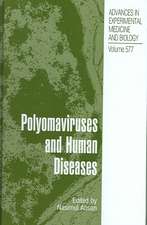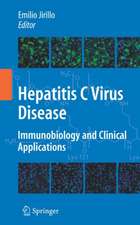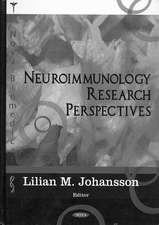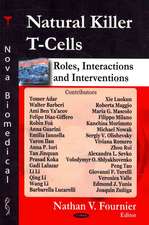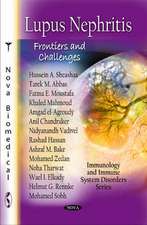Vaccine Technologies for Veterinary Viral Diseases: Methods and Protocols: Methods in Molecular Biology, cartea 2465
Editat de Alejandro Brunen Limba Engleză Paperback – 4 feb 2023
Authoritative and cutting-edge, Vaccine Technologies for Veterinary Viral Diseases: Methods and Protocols, Second Edition aims to be a useful and practical guide to researches to help further their study in this field.
| Toate formatele și edițiile | Preț | Express |
|---|---|---|
| Paperback (2) | 718.65 lei 6-8 săpt. | |
| Springer – 23 aug 2016 | 718.65 lei 6-8 săpt. | |
| Springer Us – 4 feb 2023 | 786.04 lei 6-8 săpt. | |
| Hardback (2) | 682.73 lei 38-44 zile | |
| Springer – 13 oct 2015 | 682.73 lei 38-44 zile | |
| Springer Us – 4 feb 2022 | 1226.60 lei 6-8 săpt. |
Din seria Methods in Molecular Biology
- 9%
 Preț: 791.59 lei
Preț: 791.59 lei - 23%
 Preț: 598.56 lei
Preț: 598.56 lei - 20%
 Preț: 882.95 lei
Preț: 882.95 lei -
 Preț: 252.04 lei
Preț: 252.04 lei - 5%
 Preț: 802.69 lei
Preț: 802.69 lei - 5%
 Preț: 729.61 lei
Preț: 729.61 lei - 5%
 Preț: 731.43 lei
Preț: 731.43 lei - 5%
 Preț: 741.30 lei
Preț: 741.30 lei - 5%
 Preț: 747.16 lei
Preț: 747.16 lei - 15%
 Preț: 663.45 lei
Preț: 663.45 lei - 18%
 Preț: 1025.34 lei
Preț: 1025.34 lei - 5%
 Preț: 734.57 lei
Preț: 734.57 lei - 18%
 Preț: 914.20 lei
Preț: 914.20 lei - 15%
 Preț: 664.61 lei
Preț: 664.61 lei - 15%
 Preț: 654.12 lei
Preț: 654.12 lei - 18%
 Preț: 1414.74 lei
Preț: 1414.74 lei - 5%
 Preț: 742.60 lei
Preț: 742.60 lei - 20%
 Preț: 821.63 lei
Preț: 821.63 lei - 18%
 Preț: 972.30 lei
Preț: 972.30 lei - 15%
 Preț: 660.49 lei
Preț: 660.49 lei - 5%
 Preț: 738.41 lei
Preț: 738.41 lei - 18%
 Preț: 984.92 lei
Preț: 984.92 lei - 5%
 Preț: 733.29 lei
Preț: 733.29 lei -
 Preț: 392.58 lei
Preț: 392.58 lei - 5%
 Preț: 746.26 lei
Preț: 746.26 lei - 18%
 Preț: 962.66 lei
Preț: 962.66 lei - 23%
 Preț: 860.21 lei
Preț: 860.21 lei - 15%
 Preț: 652.64 lei
Preț: 652.64 lei - 5%
 Preț: 1055.50 lei
Preț: 1055.50 lei - 23%
 Preț: 883.85 lei
Preț: 883.85 lei - 19%
 Preț: 491.88 lei
Preț: 491.88 lei - 5%
 Preț: 1038.84 lei
Preț: 1038.84 lei - 5%
 Preț: 524.15 lei
Preț: 524.15 lei - 18%
 Preț: 2122.34 lei
Preț: 2122.34 lei - 5%
 Preț: 1299.23 lei
Preț: 1299.23 lei - 5%
 Preț: 1339.10 lei
Preț: 1339.10 lei - 18%
 Preț: 1390.26 lei
Preț: 1390.26 lei - 18%
 Preț: 1395.63 lei
Preț: 1395.63 lei - 18%
 Preț: 1129.65 lei
Preț: 1129.65 lei - 18%
 Preț: 1408.26 lei
Preț: 1408.26 lei - 18%
 Preț: 1124.92 lei
Preț: 1124.92 lei - 18%
 Preț: 966.27 lei
Preț: 966.27 lei - 5%
 Preț: 1299.99 lei
Preț: 1299.99 lei - 5%
 Preț: 1108.51 lei
Preț: 1108.51 lei - 5%
 Preț: 983.72 lei
Preț: 983.72 lei - 5%
 Preț: 728.16 lei
Preț: 728.16 lei - 18%
 Preț: 1118.62 lei
Preț: 1118.62 lei - 18%
 Preț: 955.25 lei
Preț: 955.25 lei - 5%
 Preț: 1035.60 lei
Preț: 1035.60 lei - 18%
 Preț: 1400.35 lei
Preț: 1400.35 lei
Preț: 786.04 lei
Preț vechi: 958.59 lei
-18% Nou
Puncte Express: 1179
Preț estimativ în valută:
150.43€ • 155.40$ • 125.19£
150.43€ • 155.40$ • 125.19£
Carte tipărită la comandă
Livrare economică 25 martie-08 aprilie
Preluare comenzi: 021 569.72.76
Specificații
ISBN-13: 9781071621707
ISBN-10: 107162170X
Pagini: 306
Ilustrații: XI, 306 p. 54 illus., 43 illus. in color.
Dimensiuni: 178 x 254 mm
Greutate: 0.56 kg
Ediția:2nd ed. 2022
Editura: Springer Us
Colecția Humana
Seria Methods in Molecular Biology
Locul publicării:New York, NY, United States
ISBN-10: 107162170X
Pagini: 306
Ilustrații: XI, 306 p. 54 illus., 43 illus. in color.
Dimensiuni: 178 x 254 mm
Greutate: 0.56 kg
Ediția:2nd ed. 2022
Editura: Springer Us
Colecția Humana
Seria Methods in Molecular Biology
Locul publicării:New York, NY, United States
Cuprins
An overview of veterinary viral diseases and vaccine technologies.- Production and purification of candidate subunit vaccines by IC-tagging protein encapsulation.- Elastin‐like polymers as nanovaccines: protein engineering of self‐assembled, epitope-exposing nanoparticles.- Display of heterologous proteins in Bacillus subtilis biofilms for enteric immunization.- Production of influenza H5 vaccine oligomers in plants.- DNA vaccines in pigs: from immunization to antigen identification.- Use of foot-and-mouth disease virus non-coding synthetic RNAs as vaccine adjuvants.- Evaluation of innate lymphoid cells and dendritic cells following viral vector vaccination.- Generation of replication deficient human adenovirus 5 (Ad5) vectored FMD vaccines.- Recombinant modified vaccinia virus Ankara development to express VP2, NS1, and VP7 proteins of Bluetongue virus.- Cloning strategies for the generation of recombinant capripoxvirus through the use of screening and selection markers.- Using Rift Valley fever virus as a vector platform for the expression of ruminant disease antigens.- Generation and characterization of single-cycle infectious canine Influenza A Virus (sciCIV) and its use as vaccine platform.- Reverse genetics for influenza A and B viruses driven by swine polymerase I promoter.- Analysis of the cellular immune responses to vaccines.
Textul de pe ultima copertă
This second edition includes a collection of antigen production and delivery strategies for vaccine development in veterinary species. New and updated chapters guide readers through protocols for antigen production, experimental antigen delivery and the analysis of immune responses upon vaccination. Written in the format of the highly successful Methods in Molecular Biology series, each chapter includes an introduction to the topic, lists necessary materials and reagents, includes tips on troubleshooting and known pitfalls, and step-by-step, readily reproducible protocols.
Authoritative and cutting-edge, Vaccine Technologies for Veterinary Viral Diseases: Methods and Protocols, Second Edition aims to be a useful and practical guide to researches to help further their study in this field.
Caracteristici
Includes cutting-edge methods and protocols Provides step-by-step detail essential for reproducible results Contains key notes and implementation advice from the experts

